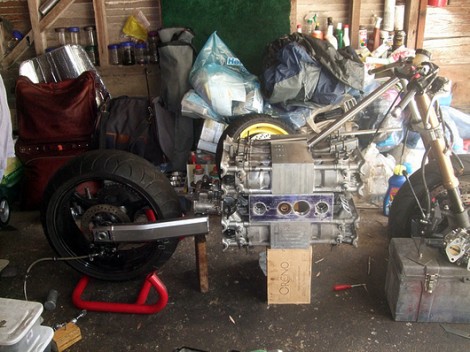
The difficulty of rolling a 16-cylinder engine into a motorcycle really boggles the mind. But that’s exactly what [Andreas Georgeades] is doing in his garage. It’s two straight-8 engines sandwiched on top of one another with a custom crankcase connecting them. And get this, those custom parts are being milled by hand, using time-tested techniques rather than modern computer assistance.
So, where does the complexity come in? Well first of all you’ve got to solve all of the problems that go along with combining two engines. It sounds like this isn’t a new concept, as older generations of Formula 1 engines used the technique. But we still think it’s the pinnacle of hardcore when it’s an enthusiast undertaking the challenge. Then there’s the issue of weight. The engine is bulky, but needs to balance in the frame. And you still must find a way for the rider to sit on the thing (even the most bow-legged of people won’t be able to get their hips around the thing).
Seems like something out of a Mario Kart game that should have no chance of being roadworthy. But we’re sure [Andreas] is going to prove us wrong.
[Thanks Th3BadWolf]
















Err.. those are flat 8s, not straight 8s. Straight would mean 8 all in a row. That is two sets of four horizontally opposed… then stacked on top of each other.
The engines appear to be a pair flat [opposed] 8 cylinder engines – not straight 8s.
It is possible. Ed Drabek installed a Ford flathead V8 [probably similar weight] in a modified Indian frame around 1950. Not very maneuverable, but a boat load or torque.
Wouldn’t that be two flat 8s, not two straight 8s?
Yes, I may be picking, but there’s a rather large difference!
It says the engines are boxers. Hence it makes an H16 with 4cylinders on each spike of the H. It will be mounted with the H tipped at 90degrees by the look of it. That thing is going to be really wide!
Right they are boxers, the reference web page mention using cylinder heads. An opposed engine is an entirely different animal, that doesn’t use cylinder heads.
“that doesn’t use cylinder heads.”
???
Porsche, VW, and BMW bike manufacturers will be perplexed…
He’s quite right.
http://en.wikipedia.org/wiki/Opposed-piston_engine
Not really understanding the Formula One reference here. I can only find one F1 engine in this configuration which is the BRM Type 75. This engine wasn’t really successful in Formula One.
From the article:
” Its design is much like the old Formula One engines built by BRM in the 1960s.”
No one said it was successful, just that it was like it.
I was referring to the HaD article rather than the source, but yeah point taken. It’s incorrect that “older generations” of F1 engines used this layout from what I can tell.
It appears only one such engine did so, and that was only used during a transitional time between the rule changes that provoked the creation of, and the eventual manufacturing of the Cosworth DFV.
It did win a Grand Prix however! US GP at Watkins Glen in 1966.
This reminds me of something..
Anyone want a V8 that you can rev to 12k?
http://www.h1v8.com/page/page/1562068.htm
Two I4 Hyabusa motors put together to make a V8.
I’ve surfed to that site. The Hayabusa already works nicely in one of the various Lotus 7-alikes. The v-busa would prolly need a Lotus 8 kit to stay within the bodywork. $32US for the engine, >$5k for the sequential trans.
Awesome machining skills!
Can’t help thinking this is a bit wasted in a bike frame though. It would absolutely rock if it was mid mounted in a mad autocross car.
wow i cant wait to see it when it’s done. but whats this? dell orto carbs? (VOMITS)
i dont envy this man when it comes time to sync those 16 carburetors
I dont envy this man when it comes to the fact the bike is going to want to rotate on it’s axis when rev’d. Hard.
I envy him!
There where (are?) 4 cylinder inline motorcycle that where ride manageable. Why not use 4 of them, although the stack would still be pretty tall, the width would be more manageable I think. There is no way this could be a cruiser. Destined to be lay on the top salt flat machine. If you dare :)High power on 2 wheels never beckoned me. Although mild small block V8 using 3 wheels sounds like fun.
But think of how much ham gear you could power with it!
I think that hacking is about ‘what you got’ [and can get] not what you wish you had.
I would not say ‘never’, ‘no way’, ‘will not work’, etc. to a hacker at work. You can reserve those comments for side bets…
Did you ever hear of the “Dolmette”? 24 chainsaw engines in one motorcycle.
example:
Humm. Fun but really. Build it with four Busa motors at 1.3 liters each and in EFI and turbos just for fun.
So 1.3 liters X 4 gives you 5.2 liters.
A busa well tuned with a turbo can give 250 HP Mr. Turbo claims up to 500 for a stage 3 kit so let’s stick to 250.
250HP X 4 == 1000HP. If you can get 300 HP your at 1200HP
Now build a car for it and Good freaking grief folks.
But what’s the torque look like? And where is the powerband? If it has low torque, and only hits at like 10K, there’s really no fun there.
There are quite a lot of 400bhp+ Hayabusa bikes. There’s even one with more than 650bhp.
There’s no “straight-8” involved here. This is four inline-4 engines bolted together.
If it was a straight-8, there would be 8-cylinders in a row.
A wildly impressive build.